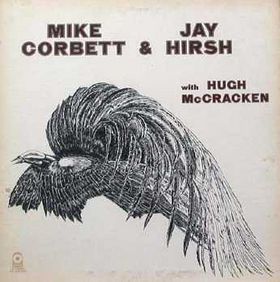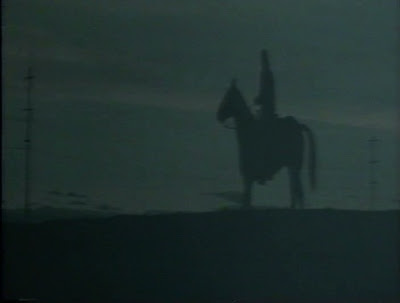You're probably saying right now, "Wait a sec- that Sylvester Stallone flick? That's out on video- this isn't hard to find. Has The G-Man finally flipped his lid?" Well, truthfully, I flipped my lid years ago... but in direct relation to our post, the answer is: "No! I'm talking about the original!"
In the years before
Rocky (heck, even before
The Lords of Flatbush), when Sylvester Stallone was still trying to pay the bills as an actor, he usually received small roles or walk-ons (like his funny appearance as a subway hood in Woody Allen's
Bananas). However, he had second billing (as
Sylvester E. Stallone) in an obscure, low-budget counterculture film called
No Place To Hide, directed in New York state by Robert Allen Schnitzler. The first billing actually goes to the lantern-jawed Antony Page, who leads a group of radicals into bombing a Manhattan building. However, the movie focuses more on Stallone's character Jerry, and his conflict in choosing between a life in radical politics or settling down at a farmhouse with his hippie girlfriend Laurie. This film no doubt quickly fell off the radar, and if weren't for the presence of the future star, the movie likely would've been forgotten altogether.
However, when Sly Stallone reached superstardom in the 1980s, a couple of projects from his salad days were re-issued to capitalize on his fame. The most notorious of these was 1970's softcore film,
The Party at Kitty and Stud's, re-issued as
The Italian Stallion. However, the most curious resurrection of these pictures was
No Place To Hide, not least in the ways in which it kept on being re-marketed. In 1981, it was re-issued with the title
Rebel, with a different soundtrack (featuring familiar oldies by Country Joe McDonald and Tommy James), and with additional footage. Stock shots of Robert Kennedy, Bob Dylan and other historical footage of the 1960s were liberally added, as was newly shot footage (in Florida and Los Angeles!) of FBI agents closing in on the radical group. This is the version that is obtainable on video: it was released on VHS by Paragon, and later on DVD by several budget labels.
But still, our pop culture hadn't heard the last of
No Place To Hide. In 1990, it was re-issued once again with the title
A Man Called... Rainbo (get it?), where the soundtrack was re-dubbed with funny dialogue a la
What's Up Tiger Lily?- ironically, it is this version that likely got the most acclaim.
But still, where is the original?
The IMDB states that the movie made its television premiere on CBS in 1988- but that was the
Rebel version, according to the episode guide of the
CBS Late Movie. However, the original film had already played at least twice on television- I saw it.
Circa 1986-7, whenever the fabled
Late Great Movies on City TV had an obscure film from the 1970s among its schedule of all-night movies, yours truly would set out to watch it, especially if it was not listed in Leonard Maltin's annual video guide (
No Place To Hide has since been added). Until I saw it, I had no idea that this film was really the
Rebel video which I saw on a shelf in one of the rental shops downtown, but didn't know until years later, that it was a re-cut.
Also from the IMDB:
The same film under the title "Rebel" is an entirely different version of the film. Director Schnitzler re-edited the film after it was not successful with the die-hard flower-power crowd. The "Rebel" version was prepared in the early 1980's and is the only version currently known to exist.
Since the original movie was still in circulation after the
Rebel edit, I doubt that this above statement is true. At the very least, it hasn't completely vanished, because I still have the last twenty minutes of it on the end of a video tape, recorded back in 1987. Because I haven't seen the original version in over 25 years, it is a pointless exercise to compare it to
Rebel, however at least I can discuss the differences in the finale, where the payoff lays.
Rebel runs 80 minutes, but I seem to recall
No Place To Hide running about 90 (yes, I kept track of such geeky things in those days). Although some old footage was cut to make Stallone look like the star, with the addition of the "new" shots, perhaps half an hour of the original movie is lost in the re-cut.
A common debate in these "hard-to-find film" posts, is over whether or not these movies are actually worth resurrecting. Once any of these elusive titles are found, they can never live up to the anticipation that has been brewing within the viewer over the years. I'll be honest-
No Place to Hide is not a lost classic; in fact, it is a very tedious affair. The plodding narrative is somewhat helped in the re-cut version, but I think the
Rebel version has removed the one virtue the original had. Whatever the failings of the 1973 movie, it however had a mood.
The dreary pacing somehow compliments the overall feeling of restlessness felt among the radicals in their sordid environments. Once the bombing plot is acted upon, and it is revealed that there is an informant in the group, the oblique framing and slow-motion blurs actually add to the paranoia. Even though the original movie is stifling with its clumsy and patchy editing, its low-key approach however leaves a impression. This mood is erased in the
Rebel cut, where the soundtrack during the bombing sequence is replaced by some stupid, generic "wacka-chaka" 70s cop show funk (which I would normally love, but not here). Further, the conclusion with the haunting images of hippies at the commune standing over a pillar of smoke rising from a dead body were made even more chilling with the reverberations of the song "Thief in the Night", by Mike Corbett and Jay Hirsh. This, plus the opening song, "I'll Find My Way", by the New York-based folk ensemble Trilogy, were replaced by more generic sounds.
Admittedly the
Rebel version is better visually, with its cleaned-up picture and restored colour - however, sometimes, restoration isn't necessarily a good thing. The
No Place To Hide print that I viewed is all reds and ugly blues, but somehow that adds to the sordid atmosphere. (At the very least, the movie offers an interesting look at the New York underground- the claustrophobic apartments, cafes and studios are a universe apart from the silver skyscrapers out of reach in the backgrounds.) Finding the original
No Place To Hide is surely not like resurrecting a Van Gogh, but at least one will recover a distinct feel, plus a crucial setting of time and place, that has been forgotten, as its canvas has been repainted over time.


















































